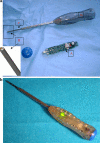Electrical conductivity measurement: a new technique to detect iatrogenic initial pedicle perforation
- PMID: 17602249
- PMCID: PMC2223337
- DOI: 10.1007/s00586-007-0409-8
Electrical conductivity measurement: a new technique to detect iatrogenic initial pedicle perforation
Abstract
Pedicle screw fixation has achieved significant popularity amongst spinal surgeons for both single and multi-level spinal fusion. Misplacement and pedicle cortical violation occurs in over 20% of screw placement and can result in potential complications such as dysthesia, paraparesis or paraplegia. There have been many advances in techniques available for navigating through the pedicle; however, these techniques are not without drawbacks. A new electrical conductivity-measuring device, previously evaluated on the porcine model to detect the pedicle violation, was evaluated amongst nine European Hospitals to be used in conjunction with the methods currently used in that centre. This new device is based on two original principles; the device is integrated in the drilling or screwing tool. The technology allows real-time detection of perforation through two independent parameters, impedance variation and evoked muscle contractions. Data was collected twofold. Initially, the surgeon was given the device and a comparison was made between the devices ability to detect a breech and the surgeon's ability to detect one using his traditional methods of pedicle preparation. In the second module of the study, the surgeon was limited to using the electrical conductivity detection device as their sole guide to detect pedicle breaches. A comparison was made between the detection ability of the device and the other detection possibilities. Post-operative fine cut CT scanning was used to detect the pedicle breaches. Overall, the 11 trial surgeons performed a total of 521 pedicle drillings on 97 patients. Initially there were 147 drillings with 23 breaches detected. The detection rate of these breaches were 22/23 for the device compared to 10/23 by the surgeon. Over both parts of the study 64 breaches (12.3%) were confirmed on post-operative CT imaging. The electrical conductivity detection device detected 63 of the 64 breaches (98.4%). There was one false negative and four false positives. This gives the device an overall sensitivity of 98% and specificity of 99% for detecting a pedicle breach. The negative predictive value was 99.8%, with a positive predictive value of 94%. No adverse event was noted with the use of the electrical conductivity device. Electrical conductivity monitoring may provide a simple, safe and sensitive method of detecting pedicle breech during routine perforation of the pedicle, in the course of pedicle screw placement.
Figures


References
-
- Amiot L, Lang K, Zippel H. Comparison accuracy between conventional and computer-assisted pedicle screw installation. J Bone Joint Surg [Br] 1998;80:240. doi: 10.1302/0301-620X.80B2.8036. - DOI
-
- Bolger C, Wigfield C. Image-guided surgery: applications to the cervical and thoracic spine and a review of the first 120 procedures. J Neurosurg. 2000;92:175–180. - PubMed
Publication types
MeSH terms
LinkOut - more resources
Full Text Sources
Other Literature Sources
Medical

